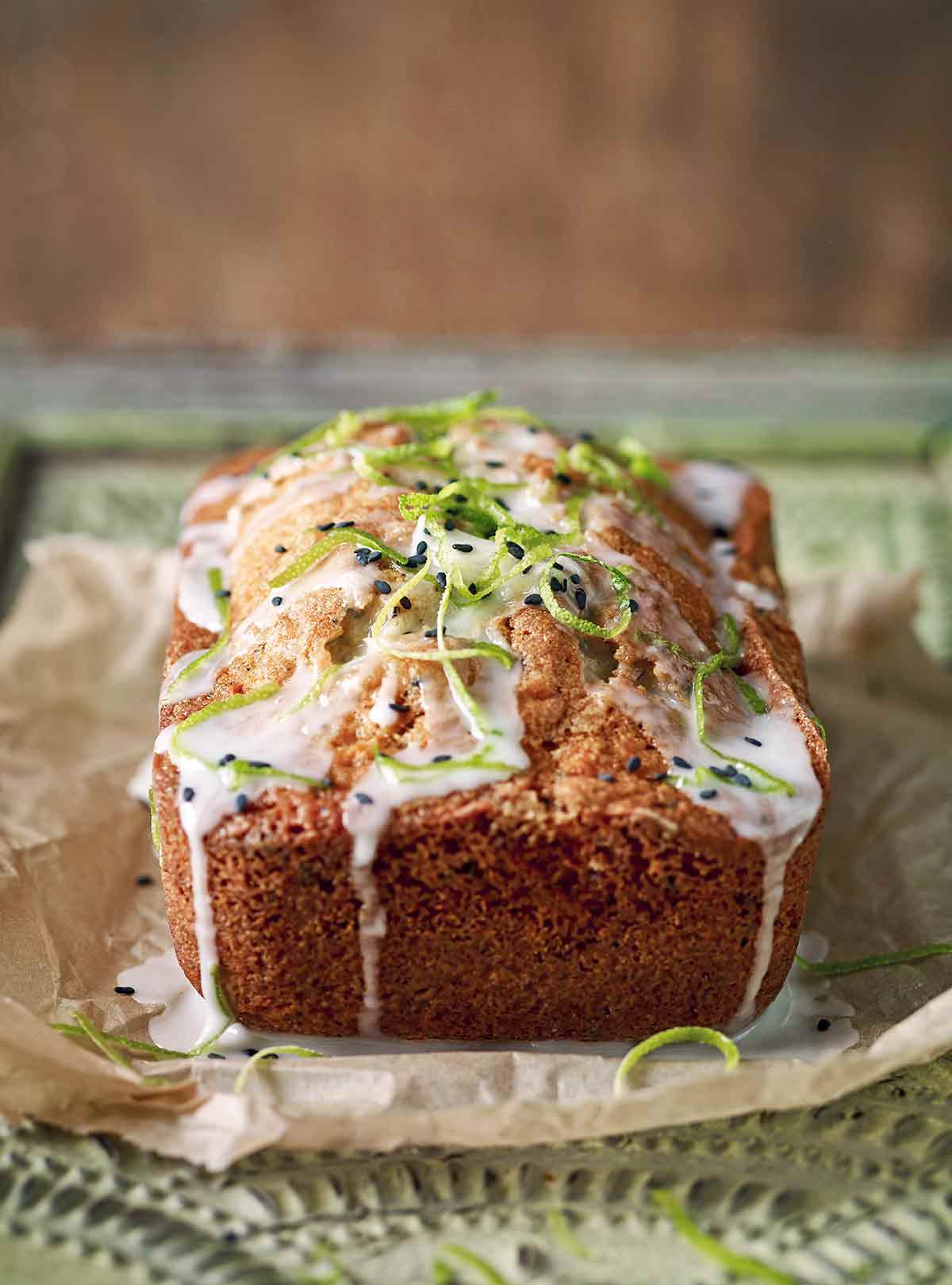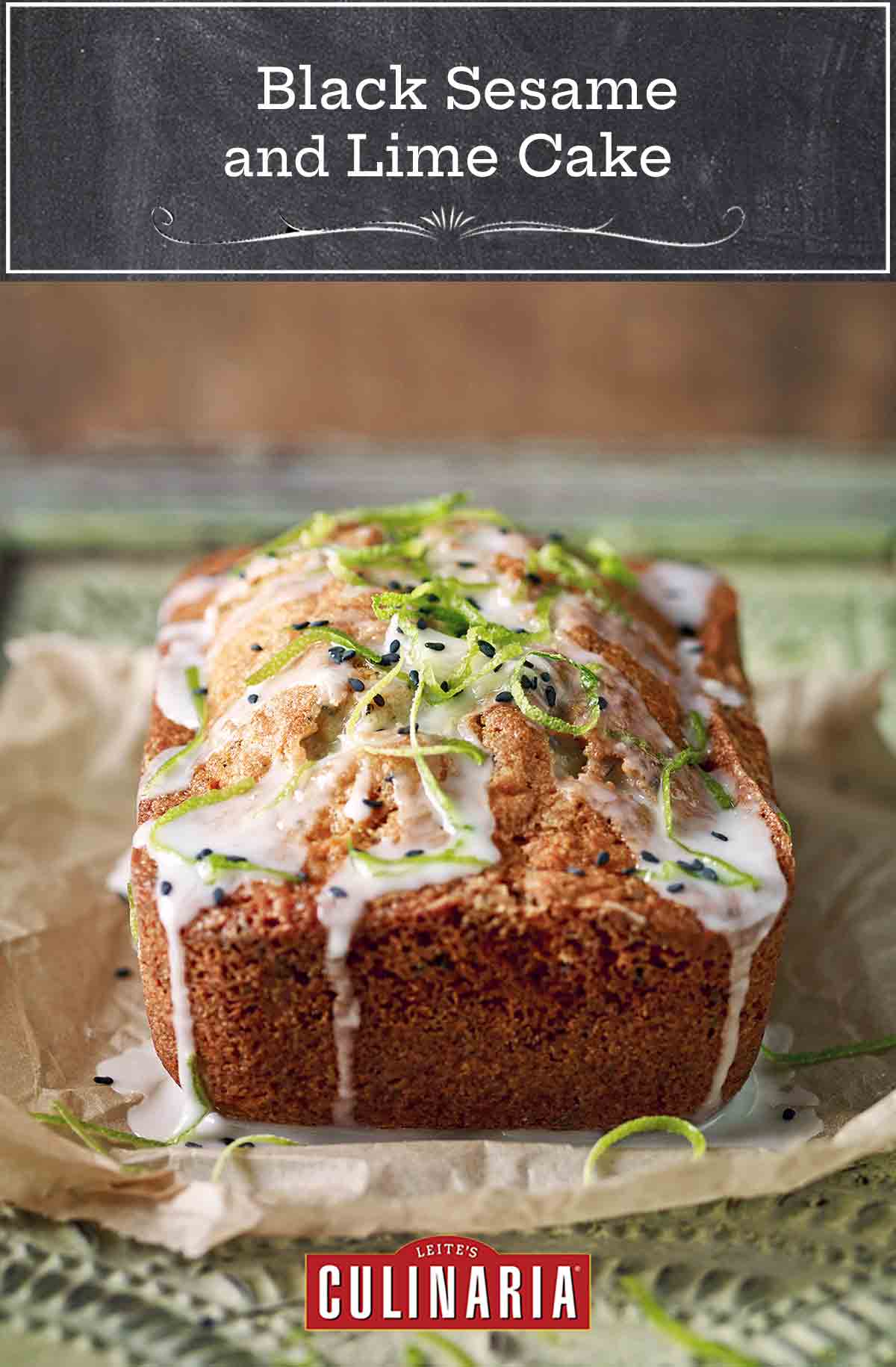
My parents’ house in India had a lime bush in the garden. As a child, I would watch the fruits growing and could not wait for them to ripen so that I could make fresh lime water. This light, refreshing loaf cake uses oranges as well as limes to make it more citrusy. Black sesame is also used quite a lot in sweet and savory cooking in India.—Chetna Makan
Black Sesame and Lime Cake FAQs
Around here, we’re all about efficiency and good tools. Just ask David about zesting citrus… Now if you want to make some perfect-looking strips of zest to decorate this lovely cake, you’re going to need either a paring knife or a vegetable peeler. Hold the knife/peeler in one hand and lime in the other. Pull the blade across the lime skin until the top part of the peel comes off in a slice. For the best zest, use a fresh lime with unblemished peel. Use only the outside colored peel, avoiding the bitter white pith.
Sesame seeds come in three varieties–unhulled black, hulled white, and unhulled white–and they’re not strictly interchangeable. White sesame seeds have a mild, nutty flavor, with the hulled variety being more delicate and a little sweeter. Black sesame seeds have a hull that’s a touch bitter, so they’re generally used with other ingredients that can stand up to the flavor, like all the gorgeous citrus used here.
Self-rising flour is made from soft wheat and contains 8% to 9% protein. Baking powder and salt are then added during the milling process to eliminate the need to add additional leavening agents. Think easy, stir-em-up and get-em-on-the-table kinds of things like pancakes, muffins, biscuits, and dumplings. If you don’t have self-rising flour you can make your own. Whisk together 1 cup all-purpose flour (120 g) + 1 1/2 teaspoons baking powder + 1/4 teaspoon salt, then use as directed.

Black Sesame and Lime Cake
Ingredients
For the cake
- 11 tablespoons (5 1/2 ounces) unsalted butter, at room temperature, plus extra for the pan
- 1 tablespoon black sesame seeds
- 3/4 cup superfine sugar (or blitz granulated sugar in a food processor until finely ground)
- 1 cup self-rising flour
- 1/2 teaspoon baking powder
- 3 large eggs
- Finely grated zest of 2 oranges, preferably organic
- Finely grated zest of 2 limes, preferably organic
- 1 tablespoon fresh orange juice
For the icing and decoration
- Scant cup confectioners’ sugar, sifted
- 2 tablespoons fresh lime juice, plus more if needed
- Finely grated zest of 1 lime, preferably organic
- Black sesame seeds, for sprinkling
- Fine strips of lime rind, for sprinkling, preferably organic
Instructions
Make the cake
- Preheat the oven to 350°F (180°C). Butter a 9- by 5-inch (23- by 13-cm) or 8 1/2- by 4 1/2-inch (22- by 12-cm) loaf pan and line it with parchment paper.
- In a small skillet over medium heat, dry roast the sesame seeds until fragrant, 2 to 4 minutes. Transfer to a and crush them lightly with the pestle.
- In a large bowl, combine the butter, sugar, flour, baking powder, eggs, zest, and juice, and mix with a hand mixer until the batter is light and creamy, about 2 minutes. Take care not to overbeat the batter as this can result in your cake sinking during baking. Add the crushed sesame seeds.
- Pour the batter into the prepared pan and bake until a skewer inserted into the center of the cake comes out clean, 35 to 40 minutes. Leave the cake to cool in the pan for 10 minutes, then turn out onto a wire rack and leave to cool completely.
Make the icing
- In a small bowl, mix the confectioners’ sugar with the lime juice and zest to produce a runny paste. If necessary, stir in more lime juice to achieve the desired consistency.
- Spoon this mixture over the cake, then sprinkle some sesame seeds and lime rind strips on top to finish. This cake will keep in an airtight container for up to 5 days.

Nutrition
Nutrition information is automatically calculated, so should only be used as an approximation.
Recipe Testers’ Reviews
This black sesame and lime cake is a light cake, made with just 4 base ingredients and very similar to a pound cake. The addition of zest and citrus juice gives it a pleasant freshness, which is more intense the day it is prepared. Sesame seeds give it a certain crunchiness, which goes great with the texture of the cake. Simple, fast, delicious!
The black sesame seeds are crunchy and nutty, and they look great, especially with the extra lime rind on top. The lime and orange are tangy and balance the sweetness. While my cake collapsed in the middle resulting in a V shape, the flavor was uncompromised, and I was able to cut six good-sized slices.
This very citrusy black sesame and lime cake is a delight and goes great with a strong cup of black tea. The orange and lime flavors are well balanced, and the sesame seeds add a subtle nuttiness. If you are making your own self-rising flour by adding baking powder to flour, don’t be like me and forget to add the extra baking powder as a stand-alone ingredient. It really needs it, or you’ll end up with a flat loaf, but even so, it is very delicious.













Hello! If I am making my own “self-rising” flour by adding 1½ tsp. baking powder + ¼ tsp. salt, I just want to confirm that I’m also adding the additional ½ teaspoon baking powder that is called for separately in the recipe, is that right? So it would be a total of 2 tsp. baking powder? Also, is this fine salt or kosher salt? Thank you, I can’t wait to try this recipe!
Great question, Dafna. Yes, you are correct—with the self-rising flour substitute, there will be a total of 2 teaspoons of baking powder going into the cake batter. As to the salt, I’ve used both kosher (mine is Diamond Crystal) and fine sea salt with good results. Let us know how the cake turns out!
Any advice for adjustments to make when baking this at altitude? We’re at 6,000 feet and the combination of self rising flour and baking powder sounds like a recipe for collapse up here.
Susan, baking at high altitude can be tricky sometimes. For this recipe I would suggest you reduce the baking powder by 1/2 teaspoon and reduce the sugar by 1 1/2 tablespoons. You may find increasing the oven temperature by 25°F will also help. This may alter your baking times so I would suggest you start checking your cake at 25 minutes. I also find using extra large eggs helps by increasing the liquid volume slightly in a recipe. Please do let us know how it turns out.
Thanks!
You’re welcome, Susan!
I want to confirm that the first step actually intends to add all ingredients and mix at once and isn’t just assuming someone who bakes would know to first beat the sugar/butter, then eggs, then flour. Just want to be sure, have never seen this approach. I have black sesame and want to try this citrus cake. Thank you.
Yes, Denise, the approach is unconventional, but it seems to work. Do let us know how it turns out.